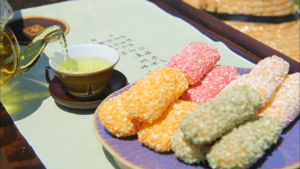Gangjeong facts for kids

Colorful gangjeong
|
|
| Type | Yugwa |
|---|---|
| Place of origin | Korea |
| Main ingredients | Glutinous rice flour; cheongju (rice wine); cooking oil; honey; beans, nuts, seeds, pollen, or spice powders |
| Korean name | |
| Hangul | |
|---|---|
| Revised Romanization | gangjeong |
| McCune–Reischauer | kangjǒng |
| IPA | [kaŋ.dʑʌŋ] |
Gangjeong (Korean: 강정) is a yummy traditional Korean sweet. It's a special type of hangwa, which means it's a traditional Korean treat. Imagine a crispy, puffed-up snack that's hollow inside! It's made from glutinous rice flour. After being deep-fried, it gets a sweet coating of honey. Then, it's covered with tasty things like nuts, seeds, or even special powders. People often enjoy Gangjeong during important family events. These include weddings, special ceremonies for ancestors called ancestral rites, and especially during Korean New Year celebrations. This sweet treat became very popular after the Goryeo Dynasty. This was because of the influence of Buddhism. In China's Yuan Dynasty, they even called it "Goryeo dessert"!
Contents
How is Gangjeong Made?
Making Gangjeong is a careful process. First, Glutinous rice is soaked in water for several days. This makes it soft enough to be ground into a fine powder.
Preparing the Dough
Next, the rice flour is mixed with cheongju (a type of rice wine) and honey. This mixture is then steamed in a special Korean steamer called a siru. A wet cloth, called a bojagi, lines the steamer.
Shaping and Drying
After steaming, the dough is kneaded until it's smooth. It's then rolled out into thin sheets, about 1 centimetre (0.39 in) thick. These sheets are cut into small rectangles, usually 3–4 centimetres (1.2–1.6 in) long and 1.5–2 centimetres (0.59–0.79 in) wide. These pieces are then dried in the shade. Drying them properly is very important for the next step.
Frying and Coating
Once the Gangjeong pieces are well-dried, they are ready for frying. They are first placed in room-temperature cooking oil. Then, they are moved to warmer oil to puff up. Finally, they are deep-fried at a high temperature until they are crispy and light. After frying, any extra oil is drained away. The crispy puffs are then coated with honey. For the final touch, they are covered with delicious nutty grains or powders. These can include toasted sesame seeds, pine nut powder, soybean powder, pine pollen, Angelica leaf powder, or cinnamon powder. This gives Gangjeong its unique flavor and look!
Images for kids





